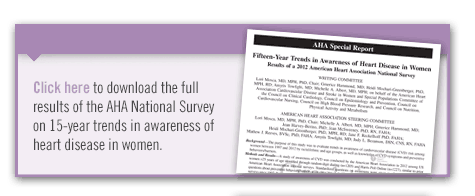In 1997, a national survey commissioned by the American Heart Association (AHA) documented that awareness of cardiovascular disease (CVD) among women was low. Since that time, the AHA and other organizations have launched campaigns to raise awareness and educate women about the hazards of CVD. In 2003, the AHA named its national initiative Go Red for Women. During the decade after the initial launch of this campaign, the rate of awareness of CVD as the leading killer of women nearly doubled. During that same time, the mortality rate caused by CVD dropped by about half for both men and women.
Analyzing Trends of CVD Awareness in Women
Since 1997, the AHA has conducted similar surveys triennially to evaluate national awareness of CVD among women. In 2013, the AHA published the results of the most recent survey in Circulation as part of a study that evaluated trends in awareness of CVD among women between 1997 and 2012. The analysis also assessed knowledge of CVD symptoms as well as preventive behaviors and barriers to CVD prevention among women aged 25 and older.
According to the findings, the rate of awareness of CVD as the leading cause of death in women nearly doubled over the 15-year period, rising from 30% in 1997 to 56% in 2012 (Table 1). The most common reasons for women taking preventive actions were to improve health and to feel better, not to live longer. In 1997, women were more likely to say that cancer was the leading killer of women, but that trend reversed in 2012.
“The rate of awareness overall has not changed significantly in the past several years,” says Heidi Mochari-Greenberger, PhD, MPH, RD, a study co-author. “There are also substantial CVD awareness gaps among racial and ethnic minorities when compared with Caucasian women.” The rate of awareness among African-American and Hispanic women in 2012 was similar to that of Caucasian women in 1997.
“There is a potential opportunity for physicians to identify women at risk for CVD earlier in life. This is a time when lifestyle and other preventive efforts can have a significant impact on future health.”
Improvements have been seen with regard to recognizing atypical symptoms of heart attack, but the study notes that, overall, awareness remains quite low (Table 2). Women are more likely now to call emergency services if a heart attack is suspected, but they typically will do this on behalf of someone else rather than for themselves. More data are needed to understand the barriers and psychosocial factors that women face when signs or symptoms of a heart attack appear.
Targeting CVD Educational Efforts
Based on the study results, Dr. Mochari-Greenberger says that future educational efforts should be targeted to racial and ethnic minorities who have lower rates of awareness and higher rates of CVD mortality and risk factors. “More is needed to improve CVD awareness among minority women,” she says. Furthermore, relatively few data are available on the effectiveness of intervention strategies for CVD in different racial and ethnic minority groups.
Missed Opportunities to Identify Women at CVD Risk
For women between the ages of 25 and 34, the rate of awareness of CVD as the leading cause of death was lower than that of older women. “Younger women reported different barriers to prevention than older women,” says Dr. Mochari-Greenberger. “They were also more likely to report that their doctor never spoke to them about their heart disease risk. There is a potential opportunity for physicians to identify women at risk for CVD earlier in life. This is a time when lifestyle and other preventive efforts can have a significant impact on future health.”
To reduce CVD risk in younger women, strategies are needed to overcome age-specific barriers to heart-healthy living. Adhering to prevention guidelines and assessing pregnancy-related CVD risk and psycho-social factors are also paramount. Many women are familiar with traditional methods for CVD prevention, but this AHA study showed that there is still a great deal of misinformation on many strategies that are not evidence based or recommended in guidelines.
According to Dr. Mochari-Greenberger, how health information is disseminated is critical to further improving awareness of CVD among women. “More research is needed to better understand the reasons why awareness is still suboptimal. The women and heart disease movement can build on these recently observed gains in awareness by encouraging heart-healthy lifestyles as a leading strategy to improve health and help women feel better. Focusing on longevity alone may not be enough.”




 admin
admin